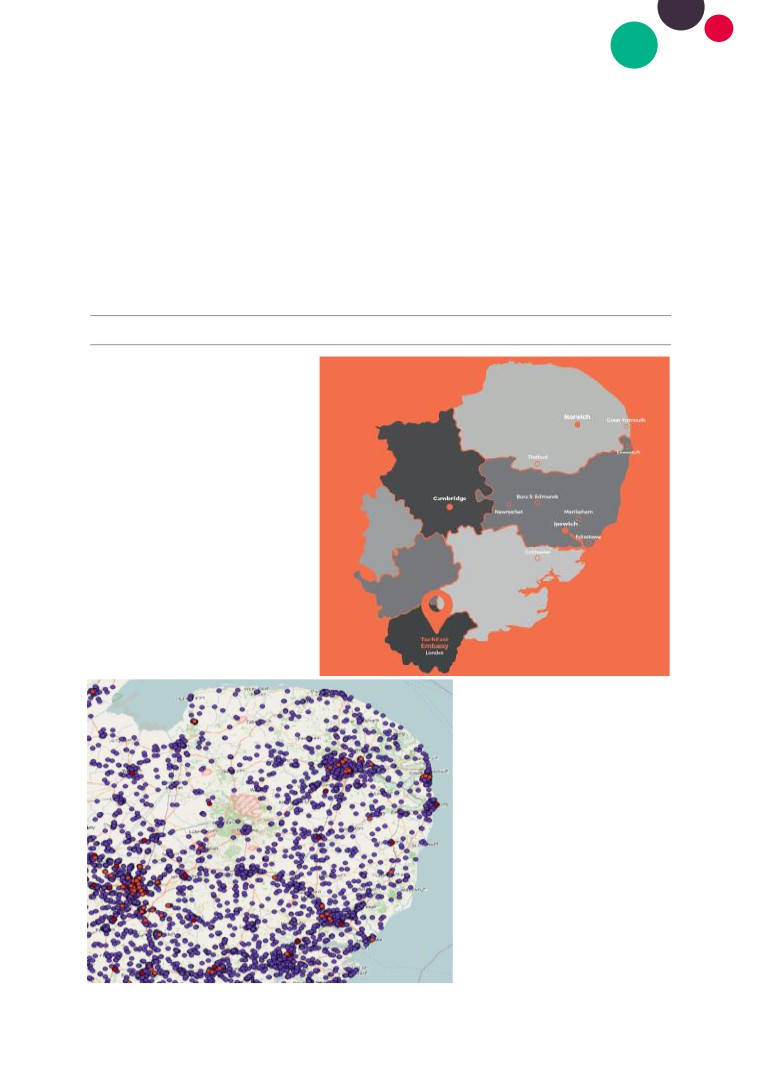DIGITAL TECH
A Skills Plan for New Anglia
November 2017
Page|1
Welcome to the Digital Tech Skills Plan for New Anglia. It sets
out our collective vision for how skills development can
support the growth of the Digital Tech sector, increasing local
competitiveness, supporting economic growth and building
high quality local careers in this high potential, globally-
influential dynamic sector. Consider this a ‘Green Paper’ for
further development by the sector into a roadmap or ‘White
Neil Miles
Paper’ over the coming months. Today I see this plan as the
TechEast Chair
first key step to enabling local collaboration to ensure
business growth and skills opportunities are maximised. We
look forward to businesses and education providers coming
even closer together to shape the future of a vibrant regional
tech economy in the East of England.
Contents
introduction ………………………………………………..…..……………… page 2
future priorities …………………………………………….……..…………… page 10
appendix A - Methodology ………………………………………….………. page 21
appendix B - Employment and Education Consultation ………….……… page 23
appendix C - Digital Tech Evidence Base …………………………………. page 27
The Digital Tech Skills Plan has been developed by the digital tech sector in Norfolk and Suffolk,
working alongside the New Anglia Local Enterprise Partnership, the New Anglia Skills Board and
supported by SkillsReach.
SkillsReach was contracted to facilitate and prepare eight sector skills plans for the New Anglia LEP
priority sectors. The project was commissioned by the Education and Skills Funding Agency, in
partnership with New Anglia LEP, and funded through the European Social Fund. Each Sector Skills
plan and supporting Data Pack has been developed in collaboration with local employers and other
stakeholders.
The Digital Tech Skills Plan has been developed in partnership with TechEast, the lead organisation
taking forward the further development and implementation of this plan in conjunction with New Anglia
LEP, local education institutions and other stakeholders and key sector champions.
The New Anglia Skills Board places employers at the centre of decision making on skills in Norfolk
and Suffolk to ensure the skills system becomes more responsive to the needs of employers, and the
future economy.
TechEast is the lead Digital Tech employer group for New Anglia, and aims to accelerate the growth
of the digital economy, creating a further 5,000 jobs across the East (including Cambridge),
generating an extra £650M GVA of economic growth, establishing the area as one of the UK’s top 5
Tech Clusters.
SkillsReach is an established East of England-based strategic skills consultancy with an associate
project team with extensive experience of developing skills plans.
Page|2
introduction
Overview
To ensure that the New Anglia Digital Tech sector maximises its
potential for business and the wider economy and community,
TechEast and our partners share the following ambition:
Ensuring that our local skills infrastructure enables sector growth,
supporting the take-up of 10,000 jobs, through an expanding, diverse
pipeline of talent and best in class in-career development.
The New Anglia Local Enterprise Partnership has prioritised the Digital Tech Sector as one of five
high impact sectors with the greatest opportunity for economic growth within its Strategic
Economic Plan (SEP) published in 20141. The SEP sets out major economic targets to be achieved
by 2026, including a net increase of 95,000 new jobs, 10,000 new businesses and an overall increase
in regional productivity from £36,000 to £40,000 by Gross Value Added (GVA). This plan identifies
the need for the Digital Tech sector to respond to replacement and expansion demands of
approximately 6,000 vacancies by 2024, principally at graduate and post graduate levels, plus
the TechEast sector growth aspiration to create an additional 4,000 jobs in New Anglia by
2024.
Nationally, the 2017 TechNation Report2 highlights that the Digital Economy is growing twice as fast
as the wider economy, with an economic output of approximately £100 billion per year. The Digital
Tech sector has been placed in the centre ground of driving UK competitiveness, with the emerging
Industrial Strategy and the emerging UK Digital Strategy. It is recognised as a sector that is a driver
for innovation and economic growth and an enabler for a digitally fluent, more resilient economy.
Pivotal to national developments for the sector is the role of business in guiding the planning and
delivery of the skills development that is critically important for a globally competitive market.
New Anglia’s Digital Tech sector is diverse and productive, with a total employment base of 16,600,
up nine per cent since 2010, and a GVA of around £1.3bn. Employment opportunities in the region
are increasingly requiring higher skills, creating even greater demand for qualifications at degree level
and above. As well as businesses that self-define as Digital Tech, this plan recognises Digital
Tech professionals employed across all sectors in the area. There is an expanding digital
economy across New Anglia, involving marketing, finance, public services and tourism, and
recruitment opportunities for digital workers with transferable digital skills are set to accelerate
1 New Anglia LEP Strategic Economic Plan (2014), New Anglia LEP
2 TechNation 2017, TechCity
Page|3
according to replacement demand forecasts. Also, there is significant demand for competencies
across marketing and sales within a Digital Tech environment and this is set to increase.
In compiling this Skills Plan, detailed consultation with employer groups, education and other
stakeholders, including rural economy groups, Local Authority economic development and current
European Social Fund skills providers, has focused on three key themes:
• Skills gaps and barriers
• Perception of skills supply
• Employer leadership
Based on feedback from these groups, six key needs for the Digital Tech sector have been
identified:
• Fill gaps in skills provision
• Meet growing demand for higher level qualifications
• Tackle graduate talent migration
• Build industrial partnerships
• Promote careers within schools
• Combine resources and grow investment
In addition, three priorities have been identified as having the most potential to support the ambitions
of the SEP and deliver the ambitions for growth in the regional digital economy:
• Local employer skills leadership, in partnership with education and skills stakeholders
• New and Broader Talent Pipelines
• In-career learning and development
The priorities are developed within the plan into an outline implementation schedule which
incorporates practical tactical objectives alongside more strategic longer term wins.
In identifying the relationship between skills and acceleration of the sector’s competitiveness, two key
impact categories have been defined, against which the plan’s priorities and action plan have been
indexed. These are:
• Increasing Digital Tech Competitiveness Nationally
• Growing Digital Tech Economy Jobs, Businesses, and Value
Embedding employer ownership in goal setting
The Digital Tech skills plan aims to address key goals to support the economic development
priorities of the New Anglia Local Enterprise Partnership.
First and foremost, the plan aims to represent the views of the Digital Tech industry and
build a series of priorities that enable the sector to lead and take ownership of skills
requirements. The plan summarises the importance of building a responsive skills market
that is adaptive to the demands of industry, as a way of driving competitiveness. Central to
this is the reform of skills policy and delivery itself, with employers at the centre, articulating
the standards they expect to see within their industries, which will define training and
qualification outcomes. Industrial partnerships between public agencies, educational
Page|4
institutes and employers is a further key element. The aspiration is to create a future-
proofed skills partnership, able to drive national and local investment, to act as a catalyst
in driving excellence in training and to deliver added value through a responsive and ‘skills in
demand’ approach.
The plan aims to support the overall strategic development of New Anglia’s skills system.
The area’s further and higher education institutions and training community are key assets
for all sectors in the region and the education sector already demonstrates a range of
cutting-edge activity. Through the Digital Tech skills plan, the aim is to demonstrate how
priorities developed in consultation can amplify such innovation, with the intention of
achieving greater access, greater coordination and value for employers across all
sectors.
The plan aims to complement existing strategic skills development activity locally. The
focus on employer leadership aligns with opportunities for public and private sector co-
investment and with the LEP’s strategic focus on enterprise across schools, colleges and
universities. The plan also recognises the role of the New Anglia Skills Board and its key
priorities for equipping young people for success, workforce development and increasing the
overall growth in employment for the area.
Sector Value, Employment and Skills
The Digital Tech sector is an important economic engine for the New Anglia area. It
demands a highly skilled and talented labour supply, with higher than average wage
earnings and significant GVA output, indicating a productive industry that can
stimulate the retention of economic value in the local area.
e Digital Tech sector contributes
The Digital Tech sector’s contribution to
arly 4 per cent of total economic
4.7%
the New Anglia economy
ue (Gross Value Added or
A) generated, which is around
3bn of the £35.5bn generated
the New Anglia economy in
3.6%
15.
arly 5 per cent of businesses,
er 3,400 of the 72,900
2.5%
sinesses in New Anglia, are
ital Tech businesses.
ployment in the sector (as
asured by the employment
vided by Digital Tech
sinesses) stands at just under
000, or 2.5 per cent of total
ployment in the area. This
GVA
Employment
Businesses
ns well with the job numbers in
Page|5
Ipswich and Norwich identified by the TechNation16 report (as per the
image left). If we take a slightly wider measure of the sector
(using Standard Occupational Classification codes identified in
the TechNation report), and estimate for Digital Tech jobs in
traditional industries as well, then this employment figure
rises further to an estimated 24,000.
Cambridge
Average wages across all employees (both full-
Norwich
time and part-time) in the sector nationally
18,532 jobs
stand at just over £39,000pa in 2016. This is
5,306 jobs
around a six per cent increase on 2014 wage
levels. Wages range from £69,000pa for IT &
telecoms directors to nearly £27,000pa for IT
engineers.
Ipswich
Total average wages across New Anglia are
9,981 jobs
around 10 per cent lower than nationally, and
given that consultation with sector stakeholders
revealed that the pull of higher wages elsewhere
was a barrier to attracting and retaining talent, then
there is little to suggest that the Digital Tech sector is
immune from this effect. This would put average wages for the Digital Tech sector in New Anglia at
around £35,000pa. However, this is still considerably higher (c66%) than the average wage across all
sectors in New Anglia of around £21,000pa.
Forecasts suggest that employment levels within the New Anglia Digital Tech sector are set to remain
steady between now and 2024. However, this does not take into account TechEast’s original target of
5,000 new jobs created and the associated activity taking place to achieve it. Further to and
supporting this endeavour will be the intervention of the New Anglia Local Enterprise Partnership and
its identification of the Digital Tech sector as ‘high-performing’ and therefore integral to its delivery of
95,000 new jobs across the New Anglia area.
The TechEast target of 5,000 jobs includes job creation in Cambridge. If we break this target down,
t
No Qual
17%
to
No Qual
17%
13%
QCF 1
QCF 2
44%
59%
QCF 3
16%
No Qual
No Qual
17%
13%
QCF 1
QCF 2
44%
59%
QCF 3
6%
b
Job creation and loss by qualification level to 2024 (Expansion Demand)
000
10%
15%
16%
44%
13%
No Qual QCF 1
QCF 2
QCF 3
QCF 4-6
QCF 7-8
vast majority of new opportunities will be at a higher level. Again, people already working in the sector
will be able to fill some of these posts (e.g. through up-skilling), but this in itself creates the
requirement for further backfilling down the skills/job chain. Equally, not all the posts required will be
high level with some continuing demand for lower / intermediate positions.
Latest figures in New Anglia (2014/15) suggest approximately 280 Digital Tech sector apprenticeships
starts which constitute around 1.7 per cent of the total sector workforce. The large majority of these
apprenticeships are at lower qualification levels suggesting that these will make a significant
contribution to replacement demand at lower levels, but will not currently enable the sector to respond
to the higher skills challenges.
Page|7
Levels of student/graduate retention in New Anglia, and the relatively small numbers of higher level
apprenticeships in the area, mean that the challenge for the sector is concentrated in filling those
higher level roles that will come open or be created in the future, placing a significant emphasis on up-
skilling the current workforce. The Apprenticeship Levy and the emerging higher / degree
apprenticeships may create a new impetus for higher skilled recruitment and up-skilling, although
Digital Tech employers have articulated that they remain focussed on the challenge of recruiting and
retaining recent graduates.
Taking into account these factors of expansion and replacement demand, and the
TechEast target for job creation; in total the overall jobs challenge for the sector is to
fill 10,000 posts.
Sector Activity
In close proximity to two of the most
important tech clusters in the world
(London and Cambridge), the New
Anglia region of Norfolk and Suffolk
has a distinctive tech economy,
primarily B2B/enterprise-oriented but
with a significant number of B2C
businesses.
Source: TechEast
The data analysis shows that Digital
Tech businesses are widely spread
across New Anglia, with two main
spatial clusters, in Norwich and
Greater Ipswich. Furthermore
ICT/Digital is recognised in New
Anglia as a key enabler by other
high growth sectors including
Agritech, Cleantech, Life Sciences
and Advanced Manufacturing /
Engineering with exciting
developments such as the Internet
of Things (IoT) and Big Data. The
skills strategy will reflect the needs
for underpinning digital technology
in those priority markets and
industries.
Source: East of England Science and
Innovation Audit 2017
Page|8
Important Digital Tech spatial business clusters : Adastral Park, Suffolk
Adastral Park includes BT’s global research centre, employing approximately 3,500. This has been an
important catalyst in attracting telecommunication and hardware/software development enterprises,
with over 50 other companies located at Adastral Park.
Businesses play an important role as primary suppliers to BT (CISCO, ALCATEL) and benefit from
increased market opportunities due to proximity to BT and its related supply chain activity (KCOM,
Cisco, Huawei).
Alongside there is business incubation and support through Innovation Martlesham, which has
attracted SMEs and start ups and now houses home-grown Digital Tech businesses such as Silicon
Safe and InnStyle.
The University of Suffolk has been central to the Smart Anglia business partnership that has seen the
development of the Ipswich Waterfront Innovation Centre and works closely with Suffolk New College
for the delivery of STEM based qualifications and in the provision of apprenticeship training to BT.
Meanwhile West Suffolk College is increasingly engaged with globally recognised brands such as
ARM in apprenticeshp training.
Important Digital Tech spatial business clusters : Norwich’s Digital and Creative
cluster
Norwich features a growing and nationally significant digital cluster, with specialisms in digital creative, gaming
and app development, digital advertising and marketing. Notable home-grown success stories include Epos
Now, Proxama, Brandbank and Rainbird.
University of East Anglia (UEA) and Norwich University of the Arts (NUA) are key to the output of talent for the
Norwich area. UEA ranked consistently in the Top 20 UK universities, has global pull with students drawn to
specialisms that include computing science; computer systems engineering; business information systems;
computer graphics, imaging and multimedia; data mining; engineering and environmental science. NUA is
gaining national recognition for its UX - user experience - digital design courses. There is major demand for UX
standard skills across both digital creative primary industries, such as web and software design, and in customer
experience in the broader digital economy. UEA and NUA have also developed partnerships with AVIVA and
Virgin Money to respond to the digital demands of the FinTech finance sector and support SMEs within the local
tech networking groups.
SyncNorwich, now in its fifth year has a membership of over 1,300 members and provides a vibrant networking
programme that supports business start-up, business development and ongoing good practice sharing for the
local technology community. Other networking groups include Norfolk Developers, SyncDevelopHer, Hotsource,
Norfolk Data Science, Norfolk Games Developers and Digital East Anglia.
Main picture: Digital City 2016. 15 year old Hellesdon High School student Andy Moncur with Aviva digital software engineer Jamie McLeod. Picture: ANTONY KELLY.
Reproduced from EDP
P a g e | 10
Snapshot
DEVELOPING THE SKILLS PLAN
THROUGH COOPERATION AND AN EMPLOYER-LED PARTNERSHIP
DIGITAL
L
TECH
TECH
Skills
E
SKILLS
Board
EAST
P
PLAN
NEW ANGLIA LOCAL
DIGITAL TECHNOLOGY
ENTERPRISE
BUSINESS-LED
SECTOR
PARTNERSHIP and NEW
PARTNERSHIP
ANGLIA SKILLS BOARD
REALISING
Sector Lead
COMPETITIVE
ADVANTAGE, LOCAL
As part of the East of England region, Norfolk and
OPPORTUNITIES AND
Suffolk have worked alongside Cambridge to launch
ECONOMIC GROWTH
the Cambridge Norwich Tech Corridor, which has a
THROUGH BEST
vision to be a destination of choice for global
SKILLS INVESTMENT
technology by 2031, that includes engineering, agri-
tech and digital companies.3
FOR DIGITAL TECH IN
NEW ANGLIA
Supporting the region
overall, TechEast, a
business-led partnership
that draws in key
stakeholders from local companies, business support organisations and the Universities, was formed
in 2016 to promote New Anglia and the broader East of England Digital Tech economy. TechEast is
a primary stakeholder in the development of the region’s Digital Tech Skills priorities and its vision is
for New Anglia to be recognised as one of the 5 top tech clusters in the UK.
Given the paramount importance of developing effective business leadership and
ownership of the sector’s skills priorities, TechEast is ideally placed to be the lead
partner across New Anglia for Digital Tech Skills.
3 Leading Growth in the UK for Science, Innovation and Enterprise, Cambridge Norwich Tech Corridor (2016)
P a g e | 11
future priorities
OVERVIEW
Key needs identified during research and consultation and their fit with the three
sector priorities (P1 - Local employer skills leadership; P2 - New and Broader Talent
Pipelines; P3 - In-career learning and development):
Meet growing
Fill gaps in skills
demand for higher
provision
level qualifications
P2
&3
Tackle graduate
Build industrial
talent migration
partnerships
P1
Combine
Promote careers
P2
resources and
within schools
grow investment
Key impact categories:
GROW
INCREASE
THE DIGITAL
DIGITAL TECH
TECH ECONOMY
COMPETITIVENESS
P a g e | 12
To ensure that the New Anglia Digital Tech sector maximises its
potential for business and the wider economy and community,
TechEast and our partners share the following ambition:
Ensuring that our local skills infrastructure enables sector growth,
supporting the take-up of 10,000 jobs, through an expanding, diverse
pipeline of talent and best in class in-career development.
TARGETING THE PRIORITIES
Pinpointing the areas that will deliver a major contribution to growth of the sector
1
2
3
PRIORITY ONE
PRIORITY TWO
PRIORITY THREE
Local Employer Skills
New and broader talent
In-career learning and
Leadership
pipelines
development
What the goal is
Develop closer collaboration
Stimulate the pipeline of talent for
Ensure existing sector employees
between Digital Tech sector
the sector to overcome skills
are competent, enterprising,
business and skills providers to
shortages in higher technical and
adaptable and able to apply leading
improve the responsiveness,
management skills; create
edge solutions in a rapidly changing
accessibility and value of skills
alternative pathways for graduate-
industry through effective
outcomes for local employers and
level talent and raise awareness
coordination of bespoke in-career
residents
in schools of sector career
technical and professional learning
choices
and development
What success looks like
New Digital Skills Task Force to
Sector has access to sufficient,
A dynamic, local learning and
develop investment and excellence
diverse talent to fulfil employer
enterprise development environment
in the sector's skills offer, articulating
business growth aspirations,
facilitating high quality continuing
and responding to employer needs
attract talent from elsewhere and
technical and general professional
and maximising opportunities for
provide exciting opportunities for
development for the specialist and
New Anglia's residents
residents
wider business community
Where it will have impact
Increasing Digital Tech
Increasing Digital Tech
Growing Digital Tech
Competitiveness Nationally
Competitiveness
Economy Jobs,
Nationally
Businesses, and Value
Growing Digital Tech
Economy Jobs,
Businesses, and Value
P a g e | 13
Priority 1 : Local Employer Skills Leadership
Growing Digital Tech Competitiveness and the Digital Economy
Effective business leadership and ownership of the sector’s skills priorities is vital. TechEast, working
with the New Anglia Skills Board, would be ideally placed to be the lead partnership across New
Anglia for Digital Tech Skills. Central to this role is strategic responsibility for leveraging public and
private sector resources for the sector. The outcome of the recent East of England Science and
Innovation Audit will bring further impetus to developments locally.
The development of the skills plan has highlighted strong examples of how FE and HE are developing
cutting edge and employer-facing skills and qualification activity for the sector. However, the
interaction between businesses and skills providers is mixed and there is a perception that the overall
offer does not fully meet the demands of industry. New Anglia’s skills providers and universities
should therefore be supported by TechEast, to develop closer collaboration to improve the
responsiveness, accessibility and value of skills outcomes for local employers.
OBJECTIVE - Create a new Digital Tech Skills Task Force, led by TechEast, to articulate
and respond to the sector’s skills needs. The Skills Task Force should aim to maximise
the investment in skills development for the sector by leveraging resources from public
and private investment, leading to the development of a world class digital skills offer
for New Anglia’s businesses and residents.
ACTIONS
TechEast to establish a Skills Task Force as a sub-committee to the main TechEast Board,
with a recommended focus on establishing direct relationships with government on the new Industrial
Strategy and the emerging national Digital Partnership. A key output from the Task Force should be
a Digital Tech Skills Investment Strategy, including an assessment of relevant national skills
investment opportunities and identifying opportunities to collaborate with local partners such
as universities and FE Colleges to develop compelling funding proposals.
TechEast to lead the development of a Digital Tech Skills Observatory, which can support
the Digital Tech Skills Task Force. The Observatory should be developed in partnership with
national stakeholders, New Anglia’s HEIs, FE, the lead independent training stakeholder and
business partnership members. The Digital Tech Skills Observatory would establish the key skills
demands and gaps in New Anglia’s digital industry and develop mechanisms to regularly plan and
review the dissemination of key information for skills providers, careers stakeholders and Digital
Tech business networks.
TechEast should proactively build collaborative relationships with HEIs and FE (and
through to schools) across New Anglia to ensure effective channels for communicating employer-
led skills development and to ensure effective coordination of national investment opportunities.
P a g e | 14
OBJECTIVE - Improve the standard and impact of technical digital skills through
greater collaboration amongst employers to define and share skills solutions, working
in partnership with New Anglia’s skills institutions.
ACTIONS
New Anglia Skills Board and TechEast to work together to identify how the reform of
apprenticeships - the Levy, Standards and Higher-Degree level pathways - can stimulate an
enhanced, more diverse and sustainable local Digital Tech skills supply. TechEast to be
supported in leading a Skills Reform action plan that can align the high demand occupational areas
(as identified through the skills plan and ongoing role of the recommended Skills Observatory) with
updated skills standards and clear vocational pathways.
Prepare a Post-16 Digital Tech Skills Prospectus in consultation with the New Anglia FE
group and the New Anglia independent training group. Ensure the Prospectus supports key high-
impact Digital Tech occupational skill requirements and the general development of digital skills
across the New Anglia economy. The prospectus could provide ‘one-stop shop’ access to the high
quality courses available to prospective industry entrants and existing workers seeking professional
development. It will provide an invaluable resource for employers, schools, workers, young people,
and parents.
P a g e | 15
Priority 1 : Local Employer Skills Leadership : Implementation Plan
How we stand Action (Short / Medium term) Align
Outputs
Added Value
Goal
High performing sector
Establishment of a Digital
with scope to grow
NASB
Tech Skills Taskforce (DTST)
as sub group of Tech East
Board
Two nationally
significant sector
clusters
Establishment of a Digital Skills
NASB
Observatory remit for DTST
Lack of clear employer
A new cohesive,
New partnership
leadership in local
Taskforce established,
partnership skills voice for
articulating and
sector skills
Ensure effective
with clear brief and
the Digital Tech sector,
responding to employer
representation on DTST
representative
NASM
which can engage with
skills needs taking
(HEIs/FE/Schools/Other
engagement of business,
national strategic
opportunities for New
stakeholders)
education and other
opportunities for
Anglia residents into full
Lack of connectivity
stakeholders
investment
account
with Schools and
Further Education
Lead on joint review / development
of sector bespoke skills provision;
exploring potential for a Digital Tech
TechEast
prospectus that reaches out beyond
acknowledged as key
NASB
the two identified clusters to
Digital Tech employer
encompass businesses across New
sector body
Anglia including those for whom
Digital Tech is a key growth enabler
e.g. Advanced Manufacturing
HEIs of national renown
for this sector
Key: NASB: New Anglia Skills Board, NASM: New Anglia Skills Manifesto
P a g e | 16
Priority 2 : New and Broader Talent Pipelines
Growing Digital Tech Competitiveness
The skills plan consultation has highlighted a heavy and increasing reliance on graduate skills, with a
particular target of graduates with approximately two years’ post-graduation experience. There is
some evidence of employers engaging with interns and work experience that leads to permanent
employment, but overall the talent pipeline for the sector is limited. Apprenticeship provision today
plays only a minor role in Digital Tech recruitment and upskilling strategies, with numbers
being maintained, but not increasing despite a high public profile and the introduction of a
Levy.
There are skills shortages in higher technical and management skills and alternative pathways need
to be created to establish new pipelines of experienced graduate-level talent, for example through
Higher and Degree Apprenticeships, to expand the current talent pool and build on the traditional
graduate route. There is also some evidence nationally of a gender imbalance in some Digital Tech
occupations. The importance of stimulating effective career choice for entry into the sector through
schools is significant, given the replacement and growth demands identified in this analysis.
OBJECTIVE - To raise the overall profile of the Digital Tech sector across New Anglia
and establish an overarching Digital Talent Attraction Strategy to attract fresh talent
and respond to the projected high skills growth forecast for the sector.
ACTIONS
Develop a shared portal to promote the New Anglia Digital Tech sector, its
opportunities/vacancies, challenge stereotypes and inspire career entrants. Ensure place-marketing
for New Anglia has a specific focus on the Digital Tech sector, its unique infrastructure and the
careers/skills opportunities it offers.
Assess the feasibility of implementing a shared skills service for coordinating the delivery of
apprenticeship and internship/work experience activities based on occupationally critical areas
identified by the Digital Skills Task Force (including jobs brokerage and apprenticeship training
agency type services). The shared skills service would focus on the high impact roles that will drive
growth and innovation overall for the sector.
Engage with national developments aimed at creating a new Digital Partnership to raise the
profile of New Anglia Digital Tech jobs with older, skilled, talent from other parts of the UK and build
on local and regional activity, such as the East prospectus;
P a g e | 17
OBJECTIVE - To improve the aspiration of younger people to access careers within
the Digital Tech sector across New Anglia and increase their employability.
ACTION
Build connectivity with FE and Schools to increase the number of 16-18 year old career
entrants, with a focus on the emerging strategy for developing technical and coding skills within
classrooms. Engage with the Careers Enterprise Company via its devolved LEP-wide activities to
ensure coordinated, employer-sponsored, Digital Enterprise initiatives are effectively delivered
across secondary and further education. Explore the potential to build on work already being
P a g e | 18
Priority 2 : New and Broader Talent Pipelines : Implementation Plan
How we stand
Action (Short / Medium term)
Align
Outputs
Added Value
Goal
Further quantitative research
Evidence will move from
Survey of the TechEast network
on the skills sets that matter to
being anecdotal to
employers
directional
Heavy reliance on new
and recent graduate
Establish a shared portal that can build
Coordinated, inspiring sector
Increase in numbers of local
recruitment
on existing activity, which promotes the
careers and skills showcase for
people inspired by a career
Digital Tech sector, its opportunities /
employers, current and future
/ job in New Anglia Digital
vacancies, challenging stereotypes and
workers, education, careers,
Tech and the diversity of
inspires potential career entrants
NASM
other stakeholders
that talent
Skills shortages in
higher technical and
Develop and optimise undergraduate
management skills
connections with the New Anglia Digital
Sector has access to
Undergraduates inspired by
Tech sector e.g. placements and
NASD
sufficient, diverse talent
Significant increase in number
local exciting Digital Tech
innovative curriculum developments
to fulfil employer
and diversity of local
opportunities
such as Computing Modules for non-
business growth
Lack of alternative
Under/Graduate programmes
supply to graduate
Digital Tech courses
and support
aspirations; and raising
A
entrants
the bar to attract talent
Increased depth and
Digital Tech Graduate Internship
from elsewhere as well
breadth of local graduate
programmes
as providing exciting
talent pool
I
opportunities for
Evidence of age and
Extended Apprenticeship provision
Significant increase in
residents
gender stereotyping in
especially new pathways through to
availability and take-up of
New talent pipelines
some Digital Tech
Degree/Post-graduate Level in areas
Digital Tech Apprenticeships
established
occupations
such as Big Data Analytics
EL
from Level 3 through to Level 7
Broader source of
Attraction of older skilled people from
Innovative employer-led
applicants for hard to fill
Slow progress with
other parts of UK
careers and job campaigns
vacancies
new apprenticeship
including demystification of
models
apprenticeships to attract
Build connectivity with FE and
New Anglia Digital Tech
widest talent pool
Schools for 18-year-old career
opportunities understood /
entrants
valued locally and beyond
Key: NASB: New Anglia Skills Board, NASM: New Anglia Skills Manifesto, NASD: New Anglia Skills Deal, A: Apprenticeships, I: icanbea…, EL: Emerging Leaders Programme
Priority 3 : In-career Learning and Development
Growing a Digital Economy
Feedback from stakeholders has highlighted that skills needs for the sector are often too specialised
and contemporary for the traditional skills funding system, and for the future there needs to be a
greater alignment between the skills offer and local skills needs. There are excellent examples of how
Digital Tech competency planning and development is being delivered by New Anglia’s HEIs, and this
provides the opportunity to align undergraduate, postgraduate and professional competency
development.
In addition, employers have emphasised the importance of developing competent and enterprising
employees that are adaptable and able to apply solutions in a rapidly changing industry. Larger
employers and SMEs both value in-career learning and continuing professional development as a
route to improving productivity in their workforce and to demonstrate value and attract prospective
new talent. There are excellent examples of such initiatives, many of which have the potential to
provide shared learning from existing resources, where employers are prepared to collaborate for
mutual benefit.
There is little evidence, however, of effective coordination of in-career development across the area.
The data analysis shows that businesses are widely spread across the New Anglia, despite the
spatial clusters in Norwich and Ipswich, which raises issues about accessibility. A joint approach
towards in-career development, bespoke for Digital Tech and promoted broadly, could help increase
talent and retain workers. Such a strategy can play a pivotal role in driving the growth of the
overall digital economy across New Anglia’s other key sectors.
OBJECTIVE - Develop an overarching In-Career Development Framework for the
Digital Tech sector, which incorporates employer-defined key competencies to
support pre-employment and builds on existing industry best practice CPD systems.
ACTIONS
Encourage a New Anglia Digital Tech culture of continuous improvement for in-career
development, incorporating local informal learning, professional assessment, CPD and with
specialisms in each cluster designed to benefit business across New Anglia
Explore opportunities for sharing learning and models in the untapped potential of current in-
career development by employers
Explore the potential for shared public/private investment in a nationally renowned professional
development infrastructure, which could include leading initiatives incorporating open-source and
other industry sponsored learning resources e.g. MOOCs
Establish connectivity between the local Digital Tech sector and the wider New Anglia and
SME community through common development needs
P a g e | 20
Priority 3 : In-career Learning and Development : Implementation Plan
How we stand
Action (Short / Medium term)
Align
Outputs
Added Value
Goal
Skills needs often too
Establish a New Anglia Digital Tech
specialist and
workplace learning infrastructure for in-
Locally-led opportunities
contemporary for
career development including informal
Substantial increase in
increasing accessibility, local
traditional funded skills
learning, CPD and professional
locally-designed, led and
relevance, reducing travel time
NASD
system
assessment with specialisms in each
delivered CPD and
and contributing to a developing
cluster to benefit businesses across
assessment opportunities
reputation as a ‘place’ for
New Anglia. Explore opportunities for
learning and professional
A dynamic, local learning
collaboration between larger employers
development
and enterprise
Technical skills
and the broader business community
development
assessment and
environment that is part
support not locally
of the New Anglia Digital
available
Consider a co-investment
Offer facilitating high
Explore the potential for shared public /
financing model to attract
quality continuing
private investment in a nationally
NASD
Significant co-investment from
funding investment which
technical and general
renowned professional development
private and public sectors
may include
professional development
Businesses are spread
infrastructure
Apprenticeship Levy funds
for both clusters; Digital
evenly across New
Tech businesses across
Anglia despite
New Anglia and other
workforce
non-specialist businesses
concentrations in each
Establish the connectivity
seeking digital
cluster
between local Digital Tech sector
Pilot of a skills offer
New, local opportunities for local
development support
expertise (perhaps through the
targeted at non-Digital
businesses to develop their
globally-positioned largest
NASD
Tech sector SMEs seeking
digital capacity locally, perhaps
businesses initially) and the
business growth through
through a digital competency
Opportunities to
digital development
approach
support up-skilling
needs of the wider economy for
through Apprenticeship
digital development support
Levy / higher and
degree apprenticeships
Key: NASB: New Anglia Skills Board, NASM: New Anglia Skills Manifesto, NASD: New Anglia Skills Deal
P a g e | 21
appendix A
Methodology
The Digital Tech sector skills plan has been developed to support the New Anglia Local Enterprise
Partnership and its partners in identifying the role that skills can play in developing a competitive and
sustainable local economy.
Underpinning the skills plan is an assessment of how skills can help promote economic development
for New Anglia and raise competitive advantage for the Digital Tech sector. Therefore, the context for
the plan involves understanding how the sector is structured - its spatial and industrial clustering and
how its relevant markets are developing.
Defining skills
• The scope of the plan is on the existing supply of skills within New Anglia and how the supply
meets the needs of Digital Tech employers, including the supply of vocational and academic
qualifications across secondary, further and higher education and of independently-provided
technical and non-technical training.
• Skills are defined in the context of employer demands for access to a competent labour
supply. The plan therefore identifies the importance of employability skills, such as aptitude
and capability, for enterprises and how these demands can be delivered so that businesses
within the sector have an adaptive and competitive workforce.
• In considering skills across the digital economy, the plan recognises the increasing
importance played by digitally-capable roles in other traditional employment sectors of
importance to New Anglia, such as public services, finance and tourism.
• The skills plan addresses strategic structural skills issues, such that may increase:
o the effectiveness of those providing skills services;
o the investment made nationally in building a world-class skills infrastructure;
o the leadership that employers can develop by articulating and taking ownership of
their future skills needs.
Evidence and intelligence
Throughout, the plan aims to be evidence-based and to reflect on existing policy and research. The
research methodology involves qualitative analysis, through employer consultation focus groups
and semi-structured stakeholder interviews, together with a detailed quantitative assessment of
labour market and economic data, contained within a separate Data Pack.
The Data Pack has been structured to complement the main stages of defining and evidencing the
priorities for the skills plan. It builds on existing intelligence previously commissioned by the New
Anglia Local Enterprise Partnership and nationally defined frameworks including the TechNation
methodology and the Department for Culture, Media and Sport.
Previous research has included a review of Digital Tech sub-sectors4, namely Gaming, Animation and
Digital Creative, Smart Energy and Big Data, as well as overall sector mapping work conducted and
developed through a Task and Finish Group development plan led by the IP Network and more
recently TechEast.
Building on this previous work, the development of the skills plan has involved several key stages:
• An inception meeting with TechEast representatives, New Anglia LEP, Norfolk and Suffolk
County Councils and business representatives. Followed with ongoing planning engagement
with the TechEast Board and its representatives
• Two task and finish group meetings with business representatives based in Ipswich and
Norfolk
• Semi-structured interviews with Further Education, Higher Education and the representative
of New Anglia’s Independent Learning Provider consortium
• A skills strategy and funding review based on national policy developments, key reports and
New Anglia Local Enterprise Partnership’s strategic skills activity
• Crosscutting discussions with other stakeholders including rural economy groups, Local
Authority Economic Development officers and current ESF skills providers
• Review/approval gateways with the TechEast and New Anglia LEP Skills Boards
4 Mapping the ICT Sector in New Anglia (2015), Regeneris
appendix B
Employer Consultation
An inception meeting and two employer consultation focus groups were held to capture the main
views from a range of employers. The focus groups were invited to assess and feedback on the three
themes established for the research, in a semi-structured format which also enabled broader
employer input.
•
Skills gaps and barriers
•
Perception of skills supply
•
Employer leadership
Skills Gaps & Barriers
SMEs within the industry often feel they lack the resources to engage with apprenticeships and/or
take on Level 3-equivalent qualified staff and develop them to a degree-equivalent level
The migration of graduates out of the area is causing an overreliance on contractors, who are
expensive and transitory
Software engineering is increasingly overlooked as a profession, with cloud-based development and
transitioning, multiplication software design and AWS capability increasingly suffering from a
shortage in skills supply
Software application development for mobile solutions are particularly important for the digital
creative industry
Technical design skills with a focus on digital capability (not graphic design) are in high demand for
SMEs and larger employers in other sectors reliant on digital channels to drive their product/service
offering
Concerns that the quality of skills supply and the migration of talent was wrapped up in a larger issue
of whether New Anglia is a desired destination and has a sense of place, and hence whether place-
marketing should do more to highlight the depth and quality of careers and lifestyle for the area
Perception of skills supply
Demand for skills within the industry is predominantly at the graduate +2 years’ experience level.
There is a degree of reticence to recruit new graduates, particularly for SMEs, due to the concerns
of losing staff at the 2-year stage to other employers after investing in them
Interns and work experience placements are highly valued, particularly during the summer and
have become an effective source of return to employment once their qualifications are in place in a
try before you buy approach
Newly graduated IT software engineers often lack key competencies, particularly in applying
solutions within an enterprise environment and being able to flexibly transition to other coding
languages to achieve new business development goals
The SMEs interviewed registered low levels of engagement with both the FE and independent
training sectors, with a lack of understanding of the training offer, coupled with concerns as to the
complexity of engaging
Employers that engage in assessment and work-based training support often rely upon London-
based providers, believing the training was a better fit for industry needs.
Engagement with schools was high priority but employers find it complex and costly. Employer
events across the area, such as Digital City, have developed interaction with Universities but not
delivered the same level of engagement with local schools. Employers felt that the start of the
talent pipeline must come from better school development of Digital Tech curriculum and employer
engagement
Employer leadership
Employers felt that greater engagement with HEIs was needed to bring current and future industry
trends into the classroom, if the quality and relevancy of the graduate offer was to be developed
Those employers clustered around the two most significant spatial concentrations for the industry -
in Norwich and Ipswich’s Adastral Park - should work together to amplify the significance of the
sector and develop shared skills plans. In turn employers felt this would help Digital Tech
development spill over into surrounding areas
Existing networks were highly valued as effective channels of support for the sector and SMEs
would welcome more engagement with them, seeing them as a route to greater understanding and
integration with HE and FE
Skills should become a more visible element of supply chain interaction with the larger employers in
the area, with resources being shared and activities co-implemented where they will drive benefit to
the primary employer and their suppliers
There is some evidence of using open source competency frameworks to map and develop in-work
employability skills (SFIA) for staff, which employers would be keen to share and develop in
partnership with education establishments in pursuit of a consistent approach towards key
competency and workforce development
P a g e | 25
Education Consultation
Consultation was held in the form of semi-structured interviews with HE, FE and independent training providers. This took place via the lead Principal for the
FE consortium, via Norwich University of the Arts and University of East Anglia, and with the group lead for the independent training consortium for New
Anglia. Questions were grouped around several key themes:
• Existing Digital Tech Skills Offer
• Current Engagement with Digital Tech Employers
• Enhancing the Digital Tech Skills Offer
Theme
HEI
FE
Independent Providers
Strong digital creative presence across Norwich with
internationally-recognised lead offers on digital
design, digital advertising, AI, digital filmmaking and
animation, computing, environmental science, life
sciences and engineering
FE seeking to be proactive, for example, local
Focus more on generic business
Existing
Business schools proactively develop ongoing
initiatives across New Anglia developing Digital Tech
training - such as business
Digital Tech
business engagement, including intern placements,
specific provision in diverse areas such as
administration/ customer service training
Skills Offer
employability skills development and business
electronic/telecommunication and gaming
- than sector specific activity
support services
Developing digital capability across other faculties,
recognising the digital economy transition that many
of the larger employers are making
P a g e | 26
Theme
HEI
FE
Independent Providers
Emerging national lead on UX design and gaming
FE needs to be better connected to the sector
engine development, with involvement in
strategically to improve the skills response
apprenticeship standard definitions for UX
Current
Existing involvement of employers in lecturing and
Some ongoing work experience placements with
Some sector specific delivery in Norwich
Engagement
consultation partners on employability/key
Digital Tech employers, but recognise this needs
in IT, digital marketing, web design,
competency development within curricula
with Digital
better coordination and development
technical apprenticeships and social
Tech
media up to Level 4
Recognise SMEs struggle with resources to take on
Employers
apprentices
FE provides a natural bridge to engage schools (both
primary and secondary) in engagement of young
A range of annual events and competitions to
people in tech skills and careers
develop the partnership with employers and foster an
ongoing digital education/industry infra-structure
Emerging plans to enhance the accessibility of
FE group keen to develop a joint Digital Tech
degree apprenticeship delivery through closer
prospectus with a coordinated offer to industry, in
coordination with SMEs
response to current and future skills demands
The value of vocational training and
apprenticeships needs to be raised,
FE increasingly interested in supporting business start-
There are a number of locally-led innovative
starting with schools and with greater
up activity with their students and would welcome
curriculum and work-based learning programmes in
involvement of employers and HEIs
more partnership development with HEIs and business
the pipeline
Enhancing
support organisations to create a more seamless offer
Reform of apprenticeships from
the Digital
frameworks to standards may risk the
Tech Skills
Recognise the importance of key competency
transferability of current vocational skills
Companies in Digital Tech need to collaborate more
development and would be keen to contribute to the
Offer
across sectors
to communicate career potential for sector jobs to
development of a regulated employability framework
increase market attraction and to drive the skills offer
recognised by schools, FE, HE, independent training
Larger employers should work more
providers and employers
closely with sector SMEs to share skills
STEM based engagement with schools does not
FE as a group consortium is a key asset for New
development
enthuse young people enough to seek a career in
Anglia and would welcome closer interaction with the
STEM subjects, with no single strategy for engaging
LEP and the Skills Board on place-marketing and the
schools on the Digital Tech sector
overall skills offer
P a g e | 27
appendix C
Digital Tech Sector Evidence Base
The following text provides an overview of the Digital Tech Data Pack produced in conjunction
with this sector plan.
The Data Pack contains a full breakdown of the major economic, skills and employment factors for
the Digital Tech Sector. In particular it builds a complete picture of historic patterns of labour
market activity, alongside the size and value of the sector contrasted with a series of economic
forecasts. The key elements of the data analysis are presented below- grouped in to three areas-
the Value, Performance and Future Forecast- of the Digital Tech sector, with the full referencing
captured in the data pack itself.
Sector Value
As highlighted in the 2016 TechNation Report and summarised in this plan - New Anglia features
two nationally significant Digital Tech clusters- at Norwich and Ipswich. The activity focused on
digital creative industry and IT and telecommunications, are recognised as the key drivers for
employment share, business location, supply chain development and jobs growth. The Location
Quotient, which measures the relative concentration of employment compared to national levels,
indicates that Suffolk Coastal with a score of 1.6, is the most deeply concentrated geographical
location for the sector overall.
The Digital Tech sector contributes approximately 4% to the New Anglia LEP area’s overall GVA
and has median average earnings that is significantly higher than the average- at £39,130, which
is a rate that has increased since 2014- from £37,065. The sectors occupational breakdown
highlights a strong representation of Director, Management and other professional roles, with
approximately a third of all roles falling within this area. Both the Burning Glass (job marketing
data) and Working Futures (labour market modelling analysis) identify a significant demand for
higher skilled workers, with around 50% of all jobs advertising activity since 2012 requiring degree
level and above qualification achievement.
Current Sector Performance
The data analysis evidences that the Digital Tech sector for New Anglia has increased in overall
size, by employment share- since 2010, with an overall increase of 9%- to 16,600 employees.
Both Norwich (3,100) and Suffolk Coastal (3,700) represent the largest spatial concentrations of
employment for the area. Comparatively, the business density of the sector is lower than Greater
Cambridge and the South East LEP and the Tech Corridor running through these areas-
represents both challenges and opportunities for New Anglia.
A greater proportion of overall workers, within the sector (most significantly those that possess
higher skills, equivalent to NVQ4 and above), travel to work outside of New Anglia- as opposed to
the same comparator areas. In fact, the analysis has identified that around 4,600 of higher skilled
P a g e | 28
workers will commute daily outside of the area- with Cambridge, Cambridgeshire, Essex and
London featuring as the main destinations.
Burning Glass job marketing data identifies there are key demands for competent jobseekers
within marketing, sales and customer service type roles. Furthermore, that vacancies are often
raised by large outsourced service providers (SERCO) and a crosscutting range of employers
from traditionally non-digital areas (National Trust, Virgin Money etc.) demonstrating the
importance of digital skills as enabling factors for the broader economy. This represents a
challenging ‘skills response’ to the demands of the sector, with an employer market that requires
technically competent, professional and commercially capable employees, which may involve
working for primary digital enterprises linked to IT software engineering, telecommunications and
digital design but also across finance, manufacturing, public services, tourism and other key
sectors.
Future Sector Forecast
The Strategic Economic Plan (SEP) for the New Anglia LEP includes a key ambition for increasing
the overall level of employment and growth of businesses, for the area. Defined as a high impact
sector, Digital Tech needs to play a key role of stimulating competitive advantage for the New
Anglia economy. Given the market demands already highlighted- skills plays a fundamental role
in developing a productive and competitive digital industry. The patterns of commuting and talent
‘migration’ out of area overall demonstrates a main challenge for the development of a skilled
local labour supply, which is accessible to local employers.
The trends highlighted through the analysis of Skills Funding Agency data (SFA Data Cube) within
the data pack, shows a relatively flat growth in apprenticeship starts since 2011. The
apprenticeship frameworks covering IT Application Specialists qualifications have shown a
significant reduction since 2011, reducing from 155 to 60 starts for the 2014/15 academic year.
The apprenticeships covered within this SFA framework are mainly non-technical in role- data
input, CRM and website content management. In contrast, the number of apprenticeship starts in
IT software and professional roles has increased. In addition, social media and digital marketing
apprenticeship starts have also become part of mainstream apprenticeship delivery since 2011.
This demonstrates a shift in apprenticeship delivery that is more in line with the industry mix
locally for the Digital Tech sector and in line with the occupational profiles analysed through
Burning Glass job marketing data.
Working Futures have modelled the forecast patterns of employment for the sector until 2024 (for
the purposes of the data pack analysis the Digital Tech definition has been approximated to the
Working Futures Media and IT sectors). The performance forecast predicts a fairly flat
employment projection overall but with an increase in the number of professional, sales/customers
service roles and a decrease in administration. This correlates with the Burning Glass existing job
market behaviour and also with the shift in apprenticeship starts. Although the employment
forecast appears disappointing at a high level, there are several key issues that need to be
considered:
• there is a predicted replacement demand of around 4,000 workers between 2017 and
2024 based mainly on estimated retirement levels, particularly within engineering and
technology and senior professional roles;
• there is predicted expansion demand (i.e. jobs growth) in the same occupational areas
and also predicted across digital roles within public service organisations; and
P a g e | 29
• the demand in higher skills (degree level and above) is set to increase, with the greatest
skills demand for the replacement share also falling down to higher qualified roles;
The Working Futures forecasting methodology harnesses a range of national labour forecasting
and economic performance sources alongside the national census. It does not explicitly take into
account measures from planned activity, such as the economic development interventions
developed by Growth Deals etc. or other sector based intervention.
By grouping the data analysis for the Digital Tech sector into themes exploring the sector’s value,
its current performance and existing forecast, several key conclusions can be made that allows a
relevant context for skills prioritisation to be developed:
• The job ‘structure’ for the sector in New Anglia is becoming more high skilled, more ‘IT
technical’ and professional overall, creating therefore an even greater demand in degree
and above qualifications;
• The demand for competencies across marketing and sales within a Digital Tech
environment is also significant and set to increase;
• There is an expanding digital economy across New Anglia- with marketing, finance,
public services and tourism- all actively recruiting in digital roles, which is set to
accelerate when replacement demands are forecasted. Therefore, the demand for digital
workers with digital skills, which are transferable across sectors- will increase;
• The strong clustering that exists spatially and the growing significance of a number of key
industries for the sector, demonstrates that a proportion of employers are able to access
higher performing workers, from a skilled labour market pool. Talent/worker migration
and residency/work placed wage rate data however highlights there are clear
weaknesses in the access to higher skilled workers locally. In short, New Anglia loses a
disproportionate amount of skilled workers to other areas impacting on the overall
potential growth of the sector locally.
P a g e | 30
REALISING
COMPETITIVE
ADVANTAGE, LOCAL
OPPORTUNITIES AND
ECONOMIC GROWTH
THROUGH BEST
SKILLS INVESTMENT
FOR DIGITAL TECH IN
NEW ANGLIA
The SkillsReach New Anglia project team comprised:
•
Roy Harper, Managing Director
•
Martin & Lynn Collison, New Anglia-based Rural / Economy specialists. Sector Leads - Agri Food Tech; Life
Sciences; Ports and Logistics; and Tourism/Culture
•
David Kirkham, Sector Lead - Digital Tech; Energy; Advanced Manufacturing and Engineering; Financial and
Insurance Services
•
Adam Peacock, Data Analyst - Project Data Lead
BG Futures, Bishop Grosseteste University Campus, Longdales Road, Lincoln, LN1 3DY
Tel: 07721 499494































